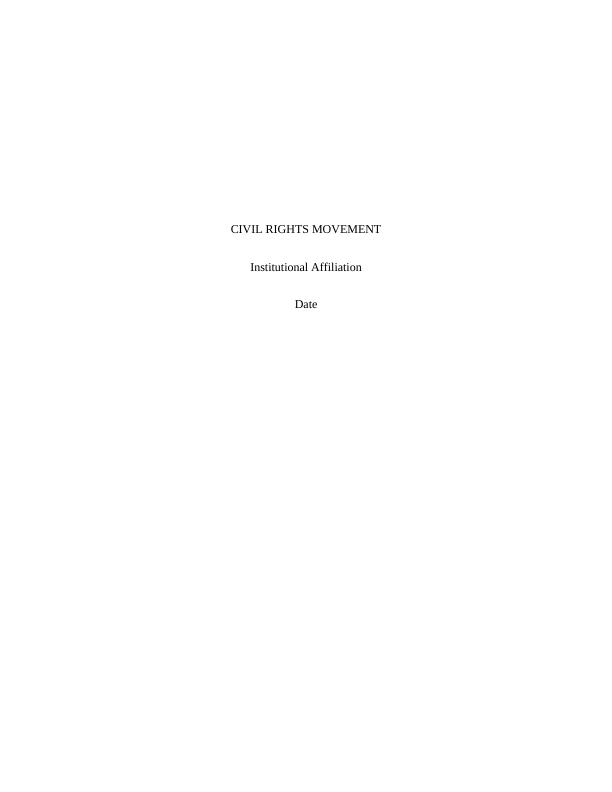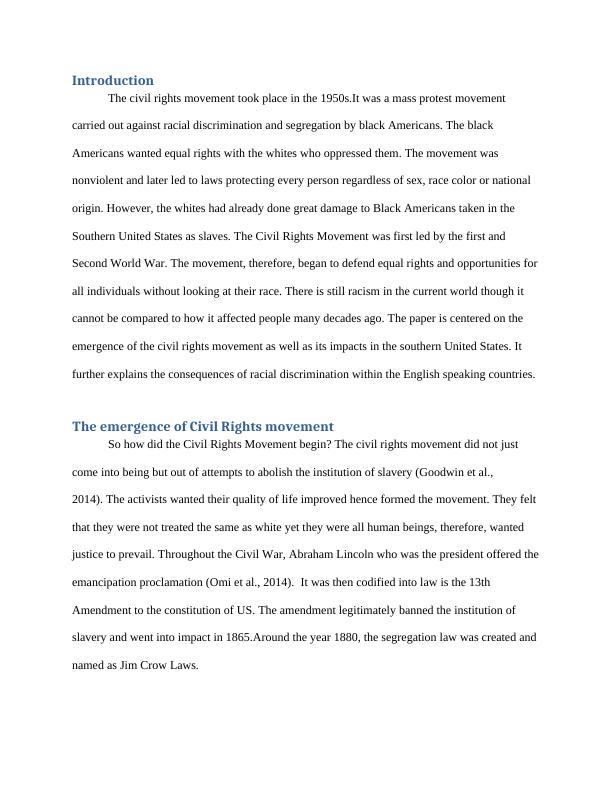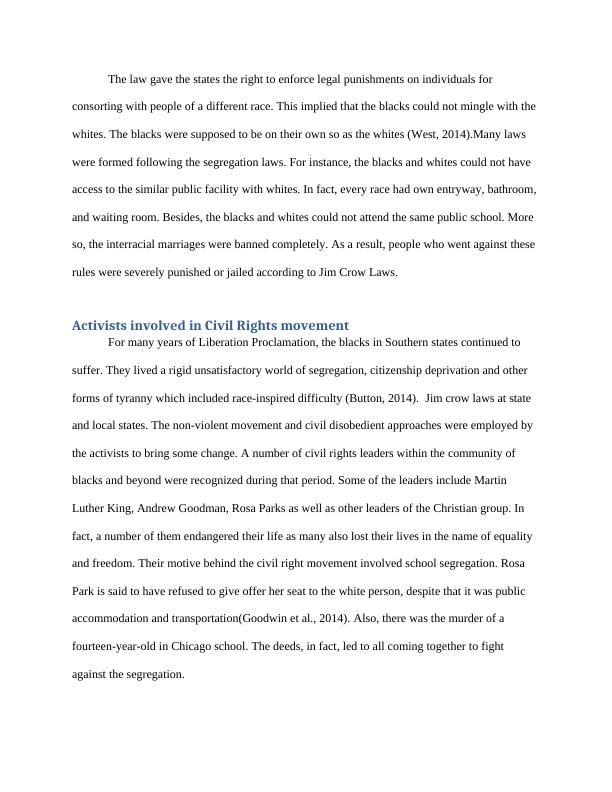Civil Rights Movement: Emergence, Activists, Impacts, and Abolitionism of Jim Crow Laws
Added on 2023-06-12
10 Pages2414 Words312 Views
CIVIL RIGHTS MOVEMENT
Institutional Affiliation
Date
Institutional Affiliation
Date

Introduction
The civil rights movement took place in the 1950s.It was a mass protest movement
carried out against racial discrimination and segregation by black Americans. The black
Americans wanted equal rights with the whites who oppressed them. The movement was
nonviolent and later led to laws protecting every person regardless of sex, race color or national
origin. However, the whites had already done great damage to Black Americans taken in the
Southern United States as slaves. The Civil Rights Movement was first led by the first and
Second World War. The movement, therefore, began to defend equal rights and opportunities for
all individuals without looking at their race. There is still racism in the current world though it
cannot be compared to how it affected people many decades ago. The paper is centered on the
emergence of the civil rights movement as well as its impacts in the southern United States. It
further explains the consequences of racial discrimination within the English speaking countries.
The emergence of Civil Rights movement
So how did the Civil Rights Movement begin? The civil rights movement did not just
come into being but out of attempts to abolish the institution of slavery (Goodwin et al.,
2014). The activists wanted their quality of life improved hence formed the movement. They felt
that they were not treated the same as white yet they were all human beings, therefore, wanted
justice to prevail. Throughout the Civil War, Abraham Lincoln who was the president offered the
emancipation proclamation (Omi et al., 2014). It was then codified into law is the 13th
Amendment to the constitution of US. The amendment legitimately banned the institution of
slavery and went into impact in 1865.Around the year 1880, the segregation law was created and
named as Jim Crow Laws.
The civil rights movement took place in the 1950s.It was a mass protest movement
carried out against racial discrimination and segregation by black Americans. The black
Americans wanted equal rights with the whites who oppressed them. The movement was
nonviolent and later led to laws protecting every person regardless of sex, race color or national
origin. However, the whites had already done great damage to Black Americans taken in the
Southern United States as slaves. The Civil Rights Movement was first led by the first and
Second World War. The movement, therefore, began to defend equal rights and opportunities for
all individuals without looking at their race. There is still racism in the current world though it
cannot be compared to how it affected people many decades ago. The paper is centered on the
emergence of the civil rights movement as well as its impacts in the southern United States. It
further explains the consequences of racial discrimination within the English speaking countries.
The emergence of Civil Rights movement
So how did the Civil Rights Movement begin? The civil rights movement did not just
come into being but out of attempts to abolish the institution of slavery (Goodwin et al.,
2014). The activists wanted their quality of life improved hence formed the movement. They felt
that they were not treated the same as white yet they were all human beings, therefore, wanted
justice to prevail. Throughout the Civil War, Abraham Lincoln who was the president offered the
emancipation proclamation (Omi et al., 2014). It was then codified into law is the 13th
Amendment to the constitution of US. The amendment legitimately banned the institution of
slavery and went into impact in 1865.Around the year 1880, the segregation law was created and
named as Jim Crow Laws.

The law gave the states the right to enforce legal punishments on individuals for
consorting with people of a different race. This implied that the blacks could not mingle with the
whites. The blacks were supposed to be on their own so as the whites (West, 2014).Many laws
were formed following the segregation laws. For instance, the blacks and whites could not have
access to the similar public facility with whites. In fact, every race had own entryway, bathroom,
and waiting room. Besides, the blacks and whites could not attend the same public school. More
so, the interracial marriages were banned completely. As a result, people who went against these
rules were severely punished or jailed according to Jim Crow Laws.
Activists involved in Civil Rights movement
For many years of Liberation Proclamation, the blacks in Southern states continued to
suffer. They lived a rigid unsatisfactory world of segregation, citizenship deprivation and other
forms of tyranny which included race-inspired difficulty (Button, 2014). Jim crow laws at state
and local states. The non-violent movement and civil disobedient approaches were employed by
the activists to bring some change. A number of civil rights leaders within the community of
blacks and beyond were recognized during that period. Some of the leaders include Martin
Luther King, Andrew Goodman, Rosa Parks as well as other leaders of the Christian group. In
fact, a number of them endangered their life as many also lost their lives in the name of equality
and freedom. Their motive behind the civil right movement involved school segregation. Rosa
Park is said to have refused to give offer her seat to the white person, despite that it was public
accommodation and transportation(Goodwin et al., 2014). Also, there was the murder of a
fourteen-year-old in Chicago school. The deeds, in fact, led to all coming together to fight
against the segregation.
consorting with people of a different race. This implied that the blacks could not mingle with the
whites. The blacks were supposed to be on their own so as the whites (West, 2014).Many laws
were formed following the segregation laws. For instance, the blacks and whites could not have
access to the similar public facility with whites. In fact, every race had own entryway, bathroom,
and waiting room. Besides, the blacks and whites could not attend the same public school. More
so, the interracial marriages were banned completely. As a result, people who went against these
rules were severely punished or jailed according to Jim Crow Laws.
Activists involved in Civil Rights movement
For many years of Liberation Proclamation, the blacks in Southern states continued to
suffer. They lived a rigid unsatisfactory world of segregation, citizenship deprivation and other
forms of tyranny which included race-inspired difficulty (Button, 2014). Jim crow laws at state
and local states. The non-violent movement and civil disobedient approaches were employed by
the activists to bring some change. A number of civil rights leaders within the community of
blacks and beyond were recognized during that period. Some of the leaders include Martin
Luther King, Andrew Goodman, Rosa Parks as well as other leaders of the Christian group. In
fact, a number of them endangered their life as many also lost their lives in the name of equality
and freedom. Their motive behind the civil right movement involved school segregation. Rosa
Park is said to have refused to give offer her seat to the white person, despite that it was public
accommodation and transportation(Goodwin et al., 2014). Also, there was the murder of a
fourteen-year-old in Chicago school. The deeds, in fact, led to all coming together to fight
against the segregation.

End of preview
Want to access all the pages? Upload your documents or become a member.
Related Documents
Civil Rights-How Far Have We Come?lg...
|8
|1896
|446
The Blacks were liberated from the clutcheslg...
|8
|2021
|12
American Historylg...
|6
|1436
|39
Survey of US Historylg...
|7
|1507
|469
Modern Day Jim Crow Laws in American Politicslg...
|5
|865
|370
Understanding Oral History and its Significance in Studying the Pastlg...
|4
|650
|1
